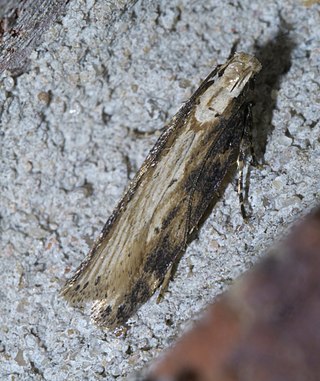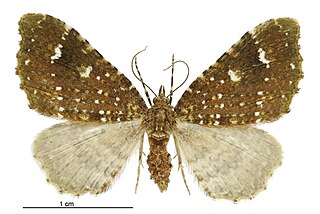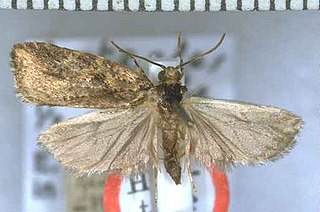
Eupselia satrapella is a species of moth of the family Depressariidae. It is found in Australia, where it has been recorded from Queensland, New South Wales and the Australian Capital Territory.

Paraswammerdamia lutarea is a moth of the family Yponomeutidae. It is found in Europe.

Glyphipterix thrasonella is a species of moth of the family Glyphipterigidae. It is found in the western part of the Palaearctic realm.

Hexadactilia trilobata is a moth of the family Pterophoridae described by Thomas Bainbrigge Fletcher in 1910. It is found in Australia in Queensland and New Guinea.
Batrachedra mylephata is a species of moth of the family Batrachedridae. It is found in Australia.
Acrocercops lophonota is a moth of the family Gracillariidae. It is known from Java, Indonesia.
Trichoptilus viduus is a moth of the family Pterophoridae that is known from South Africa.
Cathegesis angulifera is a moth in the family Gelechiidae. It was described by Walsingham in 1897. It is found on the West Indies.

Chionodes hibiscella is a moth in the family Gelechiidae. It is found in North America, where it has been recorded from Connecticut and Illinois to South Carolina, Louisiana, Mississippi and Texas.
Chionodes notandella is a moth in the family Gelechiidae. It is found in North America, where it has been recorded from Wyoming, Arizona and California.
Chionodes occidentella is a moth in the family Gelechiidae. It is found in North America, where it has been recorded from British Columbia to California and Arizona.
Chionodes phalacra is a moth in the family Gelechiidae. It is found in North America, where it has been recorded from Texas, Arizona and Mexico. It has also been recorded from Cuba.
Chionodes concinna is a moth in the family Gelechiidae. It is found in Mexico (Guerrero).
Chionodes neptica is a moth in the family Gelechiidae. It is found in Mexico (Guerrero).
Pseudotelphusa fuscopunctella is a moth of the family Gelechiidae. It is found in North America, where it has been recorded from Arkansas, Florida, Georgia, Illinois, Indiana, Kentucky, Maine, Mississippi, Pennsylvania, New Jersey, South Carolina and West Virginia.
Recurvaria thysanota is a moth of the family Gelechiidae. It is found in Mexico (Guerrero).
Compsolechia glaphyra is a moth of the family Gelechiidae. It was described by Walsingham in 1910. It is found in Mexico.
Anacampsis rhabdodes is a moth of the family Gelechiidae. It was described by Thomas de Grey in 1910. It is found in Mexico (Tabasco).

Asaphodes limonodes is a species of moth in the family Geometridae. It is endemic to New Zealand and is found in both the North and South Islands. This species inhabits damp native forest. Adults are on the wing from November until March.

Proteodes profunda is a species of moth in the family Depressariidae. It is endemic to New Zealand. This species has been collected in its type locality of Mount Holdsworth in the Tararua Range, Raurimu near Tongariru National Park, at Days Bay in Wellington, at Mount Arthur, Otira, Invercargill, and in Southland. P. profunda lives in beech forests at altitudes of around 2000 ft and larvae feed on beech tree leaves. Adults of this species are on the wing from November to February.






